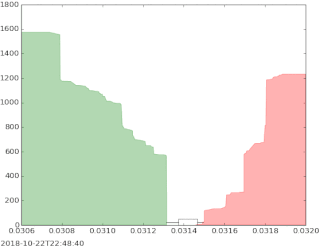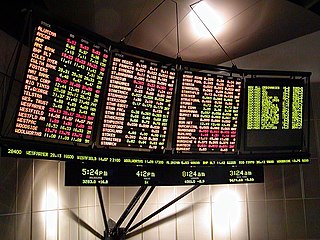In financial services, a broker-dealer is a natural person, company or other organization that engages in the business of trading securities for its own account or on behalf of its customers. Broker-dealers are at the heart of the securities and derivatives trading process.

The bid–ask spread is the difference between the prices quoted for an immediate sale (ask) and an immediate purchase (bid) for stocks, futures contracts, options, or currency pairs in some auction scenario. The size of the bid–ask spread in a security is one measure of the liquidity of the market and of the size of the transaction cost. If the spread is 0 then it is a frictionless asset.
An electronic communication network (ECN) is a type of computerized forum or network that facilitates the trading of financial products outside traditional stock exchanges. An ECN is generally an electronic system accessed by an electronic trading platform that widely disseminates orders entered by market makers to third parties and permits the orders to be executed against them in whole or in part. The primary products that are traded on ECNs are stocks and currencies. ECNs are generally passive computer-driven networks that internally match limit orders and charge a very small per share transaction fee.
Xetra is a trading venue operated by the Frankfurt Stock Exchange based in Frankfurt, Germany.
In finance, volume-weighted average price (VWAP) is the ratio of the value of a security or financial asset traded to the total volume of transactions during a trading session. It is a measure of the average trading price for the period.

Markets in Financial Instruments Directive 2014, is a directive of the European Union (EU). Together with Regulation No 600/2014 it provides a legal framework for securities markets, investment intermediaries, in addition to trading venues. The directive provides harmonised regulation for investment services of the member states of the European Economic Area — the EU member states plus Iceland, Norway and Liechtenstein. Its main objectives are to increase competition and investor protection, as well as level the playing field for market participants in investment services. It repeals Directive 2004/39/EC.
An order is an instruction to buy or sell on a trading venue such as a stock market, bond market, commodity market, financial derivative market or cryptocurrency exchange. These instructions can be simple or complicated, and can be sent to either a broker or directly to a trading venue via direct market access. There are some standard instructions for such orders.
In finance, time-weighted average price (TWAP) is the average price of a security over a specified time.
Direct market access (DMA) in financial markets is the electronic trading infrastructure that gives investors wishing to trade in financial instruments a way to interact with the order book of an exchange. Normally, trading on the order book is restricted to broker-dealers and market making firms that are members of the exchange. Using DMA, investment companies and other private traders use the information technology infrastructure of sell side firms such as investment banks and the market access that those firms possess, but control the way a trading transaction is managed themselves rather than passing the order over to the broker's own in-house traders for execution. Today, DMA is often combined with algorithmic trading giving access to many different trading strategies. Certain forms of DMA, most notably "sponsored access", have raised substantial regulatory concerns because of the possibility of a malfunction by an investor to cause widespread market disruption.
An Inter-dealer broker (IDB) is specialist financial intermediary that facilitates transactions between broker-dealers, dealer banks and other financial institutions rather than private individuals.
In finance, a dark pool is a private forum for trading securities, derivatives, and other financial instruments. Liquidity on these markets is called dark pool liquidity. The bulk of dark pool trades represent large trades by financial institutions that are offered away from public exchanges like the New York Stock Exchange and the NASDAQ, so that such trades remain confidential and outside the purview of the general investing public. The fragmentation of electronic trading platforms has allowed dark pools to be created, and they are normally accessed through crossing networks or directly among market participants via private contractual arrangements. Generally, dark pools are not available to the public, but in some cases, they may be accessed indirectly by retail investors and traders via retail brokers.
A multilateral trading facility (MTF) is a European Union regulatory term for a self-regulated financial trading venue. These are alternatives to the traditional stock exchanges where a market is made in securities, typically using electronic systems. The concept was introduced within the Markets in Financial Instruments Directive (MiFID), a European Directive designed to harmonise retail investors protection and allow investment firms to provide services throughout the EU.

In finance, an electronic trading platform also known as an online trading platform, is a computer software program that can be used to place orders for financial products over a network with a financial intermediary. Various financial products can be traded by the trading platform, over a communication network with a financial intermediary or directly between the participants or members of the trading platform. This includes products such as stocks, bonds, currencies, commodities, derivatives and others, with a financial intermediary such as brokers, market makers, Investment banks or stock exchanges. Such platforms allow electronic trading to be carried out by users from any location and are in contrast to traditional floor trading using open outcry and telephone-based trading. Sometimes the term trading platform is also used in reference to the trading software alone.
Payment for order flow (PFOF) is the compensation that a stockbroker receives from a market maker in exchange for the broker routing its clients' trades to that market maker. It is a controversial practice that has been called a "kickback" by its critics. Policymakers supportive of PFOF and several people in finance who have a favorable view of the practice have defended it for helping develop new investment apps, low-cost trading, and more efficient execution.
Flash trading, otherwise known as a flash order, is a marketable order sent to a market center that is not quoting the industry's best price or that cannot fill that order in its entirety. The order is then flashed to recipients of the venue's proprietary data feed to see if any of those firms wants to take the other side of the order.
MT4 ECN Bridge is a technology that allows a user to access the interbank foreign exchange market through the MetaTrader 4 (MT4) electronic trading platform. MT4 was designed to allow trading between a broker and its clients, so it did not provide for passing orders through to wholesale forex market via electronic communication networks (ECNs). In response, a number of third-party software companies developed Straight-through processing bridging software to allow the MT4 server to pass orders placed by clients directly to an ECN and feed trade confirmations back automatically.
An Execution management system, or EMS, is an application utilized by traders designed to display market data and provide seamless and fast access to trading destinations for the purpose of transacting orders. This application contains broker provided and independent algorithms such as TWAP and VWAP, global market data and technology that is able to help predict certain market conditions. One of the important features of EMS is the capacity to manage orders across multiple trading destinations such as stock exchanges, stock brokerage firms, crossing networks and electronic communication networks.
Smart order routing (SOR) is an automated process of handling orders, aimed at taking the best available opportunity throughout a range of different trading venues.
Transaction cost analysis (TCA), as used by institutional investors, is defined by the Financial Times as "the study of trade prices to determine whether the trades were arranged at favourable prices – low prices for purchases and high prices for sales". It is often split into two parts – pre-trade and post-trade. Recent regulations, such as the European Markets in Financial Instruments Directive, have required institutions to achieve best execution.

Securities market participants in the United States include corporations and governments issuing securities, persons and corporations buying and selling a security, the broker-dealers and exchanges which facilitate such trading, banks which safe keep assets, and regulators who monitor the markets' activities. Investors buy and sell through broker-dealers and have their assets retained by either their executing broker-dealer, a custodian bank or a prime broker. These transactions take place in the environment of equity and equity options exchanges, regulated by the U.S. Securities and Exchange Commission (SEC), or derivative exchanges, regulated by the Commodity Futures Trading Commission (CFTC). For transactions involving stocks and bonds, transfer agents assure that the ownership in each transaction is properly assigned to and held on behalf of each investor.










